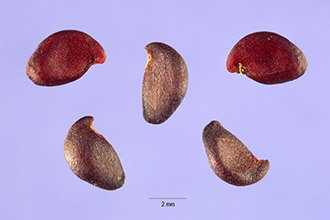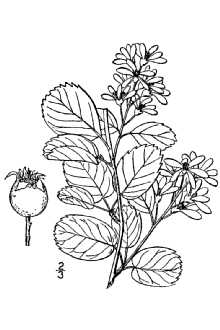Saskatoon Serviceberry
Scientific Name: Amelanchier alnifolia (Nutt.) Nutt. ex M. Roem.

| General Information | |
|---|---|
| Usda Symbol | AMAL2 |
| Group | Dicot |
| Life Cycle | Perennial |
| Growth Habits | ShrubTree, |
| Native Locations | AMAL2 |
Plant Guide
Uses
Saskatoon is planted as an ornamental and to produce commercial fruit crops. Many cultivars are commercially available, selected for desirable plant and/or fruit characteristics. Much research and literature details the development of cultivars and cultivation techniques. The fruits are used in pies, jams, and fruit rolls and for making jelly and syrup. Saskatoon wine is a regional specialty. Native Americans ate the berries fresh and dried, often mixed with other foods for sweetening and flavor. Dried and rehydrated berries were added to dried vegetables and cooked into soups and puddings. Native Americans boiled branches to make a tea for treating colds. A drink was made from the bark for stomach problems. Bark and twigs provided a medicine for recovery after childbirth. In combination with other plants, it was used to make a contraceptive. The strong and straight-grained wood was used to make arrows, digging sticks, spear shafts, tool handles, and seed beaters. Young branches were twisted into a type of rope. Saskatoon is attractive as an ornamental shrub or may be trimmed as a hedge. It is an important species for reclamation, wildlife, watershed, and shelterbelt plantings. It can be started from seed or vegetative cuttings. William R. Hewlitt © California Academy of Sciences @ CalPhotos
Status
Please consult the PLANTS Web site and your State Department of Natural Resources for this plant’s current status, such as, state noxious status and wetland indicator values.
Description
General: Rose Family (Rosaceae). Native shrubs or small trees growing to 7 meters high, variable in growth form, forming thickets, mats, or clumps, the underground portions including a massive root crown, horizontal and vertical rhizomes, and an extensive root system; bark: thin, light brown and tinged with red, smooth or shallowly fissured. Leaves are deciduous, simple, alternate, ovate to nearly round, 2.5-3 cm long, with lateral, parallel veins in 8-13 pairs, the margins coarsely serrate or dentate to below middle or sometimes entire or with only a few small teeth at the top. Flowers are in short, dense, 5-15-flowered, upright racemes, the petals white, 1-2 cm long and strap-like, sepals more or less long-hairy on the inside, reflexing in age, stamens about 20, styles 5, ovary persistently tomentose at the top. Fruit are 6-11 mm long, smooth, purple-black, slightly gray-blue waxy, the pulp fleshy and sweet; seeds 4-10. The common name refers to the city in Saskatchewan, Canada, in the heart of the species’ range. Variation within the species: Considerable variation is recognized. Var. alnifolia occurs over the whole range of the species, except for California, where only var. semiintegrifolia is found. Other varieties include the following: var. cusickii (Fern.) C.L. Hitchc. and var. humptulipensis (G.N. Jones) C.L. Hitchc.
Distribution
Saskatoon is distributed along the Pacific coast from Alaska to California, eastward to Utah, Colorado, Iowa, and Minnesota, and Ontario and Quebec, north through the plains and prairies into the Northwest Territories (Keewatin and Mackenzie) of Canada. For current distribution, please consult the Plant Profile page for this species on the PLANTS Web site.
Adaptation
Saskatoon is common in lower-elevation coniferous forests but grows sporadically up to timberline. It also occurs in montane chaparral, mountain shrub, and the upper limits of pinyon-juniper communities. In grasslands, it mostly occurs in wooded draws, woodland interfaces, and riparian zones. It occurs in open to lightly shaded disturbed sites such as thickets, fencerows, clearings, and edges of woods, and it is conspicuous after disturbances such as fire, logging, or insect outbreak. Found at elevations of 50-3000 meters; flowering April-June; and fruiting (June-)July-August.
Establishment
Saskatoon reproduces from seed but more commonly by sprouting from the root crown and rhizomes and by layering. Seedlings can take up to 5 years before they start to produce fruit, but other starts may begin at 2-4 years old and with proper management can yield 8-10 tons of fruit per hectare. Flowers are produced almost every year, but good seed crops may be produced only every 3-5 years because of drought, spring frost, and/or juniper rust. Seeds require cold stratification to break dormancy and may remain viable for 10 or more years. Natural dispersal is by birds and mammals. One individual of saskatoon is known to have reached 85 years but the average age apparently may be closer to 20 years.
Management
Saskatoon in forests is fire-dependent, occurring in forests with fire regimes varying from frequent, low-severity fire (low-elevation forests) to infrequent, severe fire. It may persist in the understory for decades but eventually dies out with fire exclusion and canopy closure. After top-kill by light- to moderate-severity fire, saskatoon sprouts usually arise from the root crown or from shallowly buried rhizomes; sprouts arise from deeply buried rhizomes after even the most intense fire. Sasktoon cover and biomass production in western Montana may generally increase after fires in Douglas-fir/ninebark habitats, but browsing pressure from big game may slow the recovery. Seed production may resume soon after fire. Cultivars, Improved and Selected Materials (and area of origin) Saskatoon has been artificially crossed with other species of serviceberry, and similar hybridization and intergradation also occurs in the field, particularly between saskatoon and low serviceberry (Amelanchier humilis Wieg.). Cultivars sold as Amelanchier alnifolia may actually be hybrids between A. alnifolia and other species of Amelanchier. Amelasorbus jackii is a hybrid of saskatoon and Cascade Mountain-ash (Sorbus scopulina.
References
Bishop, B,H, & S,H, Nelson 1980, Propagation and transplanting of saskatoon (Amelanchier alnifolia Nutt,) softwood cuttings, Canad, J, Pl, Sci, 60:883-890, Davidson, J,G,N, & R,G, St,-Pierre 1994, Saskatoons, HortScience 29(9):959-960, Howard, J,L, 1997, Amelanchier alnifolia, IN: D,G, Simmerman (compiler), The fire effects information system [Database], USDA, Forest Service, Rocky Mountain Research Station, Intermountain Fire Sciences Laboratory, Missoula, Montana, <http://www,fs,fed,us/database/feis/> Jones, G,N, 1946, American species of Amelanchier, Illinois Biol, Monogr, 20(2):1-128, Laughlin, K,M,, R,C, Smith, & ,G, Askew 1996, Juneberry for commercial and home use on the northern Great Plains, Publ, H-938, North Dakota State University Extension Service, Fargo, North Dakota, <http://www,ext,nodak,edu/extpubs/plantsci/hortcrop/h938w,htm> Mazza, G, & ,G, Davidson 1993, Saskatoon berry: A fruit crop for the prairies, Pp, 516-519, IN: J, Janick and J,E, Simon (eds,), New crops, Wiley, New York, New York, <http://www,hort,purdue,edu/newcrop/proceedings1993/V2-516,html> St-Pierre, R,G, 1992, The development of native fruit species as horticultural crops in Saskatchewan, HortScience 27(8):866, 947, St,-Pierre, R,G, 1997, Growing Saskatoons - A manual for orchardists, Completely rewritten Fifth Edition, Dept, of Horticulture Science, University of Saskatchewan, Saskatoon, Saskatchewan, Canada, St,-Pierre, R,G, 1997, Use soil moisture sensors to measure the soil moisture of Saskatoon Serviceberry., Saskatoon, Pp, 666-668 IN: The Brooks and Olmo register of fruit & nut varieties, Third Edition, ASHS Press, Alexandria, Virginia, The Native Fruit Development Program 2000, Registry of the genus Amelanchier: History & botany, cultivar overview, publications, plant & seed suppliers, Dept, of Plant Sciences, University of Saskatchewan, Canada, <http://www,ag,usask,ca/departments/plsc/nfdp/amelanchier/index,html> Weir, B,J,, R,N, Chibbar, & ,G, St,-Pierre 1994, RAPD fingerprinting cultivars of a native fruit species (Amelanchier alnifolia Nutt,, Rosaceae), a new Canadian horticultural crop, IN: P, Adams, J,S, Miller, E,M, Golenberg and J,E, Adams (eds,), Conservation of plant genes II: Utilization of ancient and modern DNA, Monogr, Syst, Bot, 48:141-148, Weir, B,J,, R,G, St,-Pierre, & R,N, Chibbar, 1997, RAPD marker polymorphism among saskatoon cultivars, clones, and seedlings, HortScience 32(6):1109-1113,
Plant Traits
Growth Requirements
| Temperature, Minimum (°F) | -62 |
|---|---|
| Adapted to Coarse Textured Soils | Yes |
| Adapted to Fine Textured Soils | Yes |
| Adapted to Medium Textured Soils | Yes |
| Anaerobic Tolerance | None |
| CaCO3 Tolerance | High |
| Cold Stratification Required | Yes |
| Drought Tolerance | Low |
| Fertility Requirement | Medium |
| Fire Tolerance | High |
| Frost Free Days, Minimum | 100 |
| Hedge Tolerance | High |
| Moisture Use | Medium |
| pH, Maximum | 8.4 |
| pH, Minimum | 4.8 |
| Planting Density per Acre, Maxim | 1700 |
| Planting Density per Acre, Minim | 700 |
| Precipitation, Maximum | 140 |
| Precipitation, Minimum | 12 |
| Root Depth, Minimum (inches) | 24 |
| Salinity Tolerance | Low |
| Shade Tolerance | Intermediate |
Morphology/Physiology
| Bloat | None |
|---|---|
| Toxicity | None |
| Resprout Ability | Yes |
| Shape and Orientation | Erect |
| Active Growth Period | Spring and Summer |
| C:N Ratio | Medium |
| Coppice Potential | No |
| Fall Conspicuous | No |
| Fire Resistant | No |
| Flower Color | White |
| Flower Conspicuous | Yes |
| Foliage Color | Green |
| Foliage Porosity Summer | Dense |
| Foliage Porosity Winter | Porous |
| Foliage Texture | Coarse |
| Fruit/Seed Conspicuous | Yes |
| Nitrogen Fixation | None |
| Low Growing Grass | No |
| Lifespan | Short |
| Leaf Retention | No |
| Known Allelopath | No |
| Height, Mature (feet) | 15.0 |
| Height at 20 Years, Maximum (fee | 15 |
| Growth Rate | Moderate |
| Growth Form | Multiple Stem |
| Fruit/Seed Color | Red |
Reproduction
| Vegetative Spread Rate | Moderate |
|---|---|
| Small Grain | No |
| Seedling Vigor | High |
| Seed Spread Rate | Slow |
| Fruit/Seed Period End | Fall |
| Seed per Pound | 60051 |
| Propagated by Tubers | No |
| Propagated by Sprigs | No |
| Propagated by Sod | No |
| Propagated by Seed | Yes |
| Propagated by Corm | No |
| Propagated by Container | Yes |
| Propagated by Bulb | No |
| Propagated by Bare Root | Yes |
| Fruit/Seed Persistence | No |
| Fruit/Seed Period Begin | Summer |
| Fruit/Seed Abundance | High |
| Commercial Availability | Routinely Available |
| Bloom Period | Early Summer |
| Propagated by Cuttings | Yes |
Suitability/Use
| Veneer Product | No |
|---|---|
| Pulpwood Product | No |
| Protein Potential | High |
| Post Product | No |
| Palatable Human | Yes |
| Palatable Graze Animal | Low |
| Palatable Browse Animal | Medium |
| Nursery Stock Product | No |
| Naval Store Product | No |
| Lumber Product | No |
| Fodder Product | No |
| Christmas Tree Product | No |
| Berry/Nut/Seed Product | Yes |

